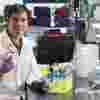Thanks to our Curestarters, Dr Luigi Nezi and his team in Italy have developed a new way to study how bacteria in our gut can influence cancer treatments. The new 3D ‘gut-on-a-chip’ is a miniature model of our own intestines, even moving as ours do while digesting food. Importantly, the model can also be ‘seeded’ with bacteria from patient samples. This means it can potentially be used to spot patients who are less likely to respond to immunotherapy, and find ways to help them.
The use of our gut-on-a-chip could help avoid unnecessary side effects for resistant patients, and give oncologists the opportunity to administer therapies that may make resistant patients more likely to respond positively.

Immunotherapy treatments use our own immune system to fight cancer. They can be hugely effective, but they also do not work for everyone.
If researchers can find out more about why this is, then many more people may benefit from these treatments. One thing that researchers have already discovered is a surprising link between the types of microbes in our intestines, and how well some immunotherapy treatments work.
These microbes are part of our ‘microbiome’- an incredibly important group of bacteria, fungi, and other microorganisms which live on and within us.
Dr Nezi’s new gut-on-a-chip model will help us better understand the microbiome and how it helps or hinders immunotherapy for cancer. It contains a tiny channel of human intestine cells. These run alongside another channel of human blood vessel cells – and they are all packed together on a small plastic chip.
This layout is designed to replicate what happens at a microscopic level in our own gut. Importantly, thanks to a collaboration with Politecnico di Milano (the Polytechnic University of Milan), the chip also uses new ‘beating technology’ which makes the mini-guts move, just like ours do when we are digesting food.


Other gut-on-a-chip models do exist. But this model is the first one to combine three important features:
- It has been designed so it can move like our gut
- It is shaped so that it is easy to apply drugs inside
- It can be seeded with microorganisms to form a simple sort of microbiome. This makes it ideal for studying exactly how our microbiome can interact with cells in our gut.
Using this innovative new bit of tech, the team studied stool samples from melanoma patients and compared patients who responded well to immunotherapy with those who had not responded.
The researchers found that stool samples from patients who had not responded to immunotherapy treatment changed how the gut cells in the model worked - they were less able to manage stress, and to renew and heal.
They also found different genetic and molecular signatures in patients who did not respond to therapy, compared to those who did.
What does this mean for patients?
These exciting findings show that this new tool can be used to understand the link between the microbiome and immunotherapy effectiveness, and also whether patients will be likely to respond to treatment.
Importantly, this new model is also designed to use cells developed from patient samples. This means the model could potentially be used as a ‘miniature patient’ - for testing and predicting which treatments are most likely to work best for patients, and making sure that patients receive the cures that are most likely to help them.

Join our united effort to stop cancer.
There are so many different ways to support our search for new cures. Will you join the 90,000+ Curestarters who are already helping us get closer to a day when no life is cut short by cancer?




